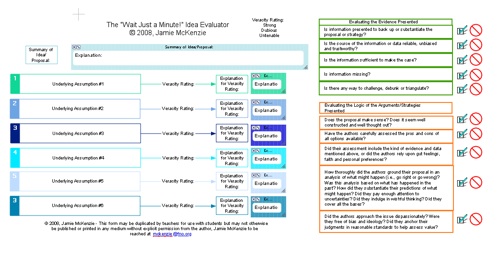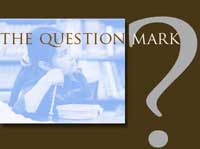Challenging Assumptions
by Jamie McKenzie
About Author
In one of the world's most impressive curriculum documents, New Zealand has made a strong appeal for schools to develop a generation of thinkers who are capable of making up their own minds:
| "Students who are competent thinkers and problem-solvers actively seek, use, and create knowledge. They reflect on their own learning, draw on personal knowledge and intuitions, ask questions, and challenge the basis of assumptions and perceptions." Source |
-
Challenging the Basis of Assumptions and Perceptions
What must teachers do to equip students with both the skills and the attitude needed so they will routinely examine the underpinnings of proposals, propositions and opinions? Ideas and opinions often circulate unchallenged as outlined in the companion article to this piece, "The Evidence Gap." They not only circulate, they are quite often embraced as truth or even become policy. When a doctor suggests a pill or a specific treatment, how many patients challenge the assumptions underlying such advice? Often they take the pills and the advice without digging to find out how strongly science supports their decision. How often do they ask about side effects? How often do they ask for data?
- "Doubts Grow Over Flu Vaccine in Elderly" - By Brenda Goodman in The New York Times
Published: September 1, 2008
-
- The influenza vaccine, which has been strongly recommended for people over 65 for more than four decades, is losing its reputation as an effective way to ward off the virus in the elderly. Article
-
- "For Widely Used Drug, Question of Usefulness Is Still Lingering" By Alex Berenson in The New York Times
Published: September 1, 2008
-
- When the Food and Drug Administration approved a new type of cholesterol-lowering medicine in 2002, it did so on the basis of a handful of clinical trials covering a total of 3,900 patients. None of the patients took the medicine for more than 12 weeks, and the trials offered no evidence that it had reduced heart attacks or cardiovascular disease, the goal of any cholesterol drug. Article
Schools must teach the young to ask tough questions so they may challenge the many "pills" being offered them as they make their way through adolescence into adulthood. The term "pills" is being used metaphorically, of course, representing everything from drugs and meds to simple answers to complex problems.
- Shall I pop this bitter little pill?
- Will this pill do me good?
- Should we drill offshore?
- Should we build a big fence along the border?
- Should we bail out the finance companies that speculated wildly?
If schools fail to meet this challenge, the young grow up prone to mentalsoftness:
|
1. Fondness for clichés and clichéd thinking - simple statements that are time worn, familiar and likely to carry surface appeal.
|
|
2. Reliance upon maxims - truisms, platitudes, banalities and hackneyed sayings - to handle demanding, complex situations requiring thought and careful consideration.
|
|
3. Appetite for bromides - the quick fix, the easy answer, the sugar coated pill, the great escape, the short cut, the template, the cheat sheet.
|
|
4. Preference for platitudes - near truths, slogans, jingles, catch phrases and buzzwords.
|
|
5. Vulnerability to propaganda, demagoguery and mass movements based on appeals to emotions, fears and prejudice.
|
|
6. Impatience with thorough and dispassionate analysis.
|
|
7. Eagerness to join some crowd or mob or other - wear, do and think what is fashionable, cool, hip, fab, or the opposite or whatever . . .
|
|
8. Hunger for vivid and dramatic packaging.
|
|
9. Fascination with the story, the play, the drama, the show, the episode and the epic rather than the idea, the question, the argument, the premise, the logic or the substance. We're not talking good stories or song lines here. We're talking pulp fiction.
|
10. Enchantment with cults, personalities, celebrities, chat, gossip, hype, speculation, buzz and blather.
The term MentalSoftness™ is a term coined by Jamie McKenzie in May, 2000. (See FNO, May, 2000, "Beyond Information Power.").
|
Picturing an Idea
 Few people stop to consider what may or may not lie below the surface of an idea or proposal. In working with students, it helps to provide them with visual images of ideas along with their supporting structures. A well formed idea is a bit like an iceberg or a building. There should be plenty of logic, supporting evidence and careful thought below the surface. The idea itself may appear as a simple sentence or two but its value depends upon its foundations much like a cathedral or a sky scraper. Few people stop to consider what may or may not lie below the surface of an idea or proposal. In working with students, it helps to provide them with visual images of ideas along with their supporting structures. A well formed idea is a bit like an iceberg or a building. There should be plenty of logic, supporting evidence and careful thought below the surface. The idea itself may appear as a simple sentence or two but its value depends upon its foundations much like a cathedral or a sky scraper.
 Continuing with the building metaphor, students are encouraged to think of themselves as building inspectors. When buying a house, smart consumers pay for a housing inspection to check all parts of the house before making a final decision. Continuing with the building metaphor, students are encouraged to think of themselves as building inspectors. When buying a house, smart consumers pay for a housing inspection to check all parts of the house before making a final decision.
- Plumbing
- Electrical Service
- Appliances
- Paint
- Roof
- Structural Soundness
- Asbestos
- Termites, Ants and other infestations
- Drainage
- Buried tanks
|
The building inspector employs a check list. Students can employ the same approach with ideas, using the checklist provided later in this article.
The Underlying Structure of an Idea
 |
We teach our students that good ideas are bolstered by three main elements:
- Sound Logic
- Sufficient Evidence
- Standards
|
Painting © Sarah McKenzie
Visit her online gallery at http://sarahmckenzie.com
|
Students learn to strip away the outer coatings and veneer to see what lies below the surface of the idea. This is what we mean by teaching them to challenge assumptions. First they must first identify the assumptions. Then they must see how worthy they are.
- Do the assumptions stand up to demanding questions?
- Are the assumptions based on something more than wishful thinking? passionate belief?
- Is there abundant evidence to bolster the assumptions?
 Example - Offshore Drilling in the USA Example - Offshore Drilling in the USA
Prior to the presidential campaign, both Senators McCain and Obama were generally opposed to offshore drilling. As gas prices soared and the American public became increasingly hard pressed at the pump, Senator McCain shifted his position and began arguing for offshore drilling at the same time that President Bush called for drilling, arguing that this act would reduce dependence upon foreign oil and lead to lower prices at the pump. Before long, Senator Obama and the Democratic Party seemed more open to the possibility as public opinion polls showed voters to be enthusiastic about the strategy.
Simply stated, the idea or proposal would read like this . . .
"Drill offshore now to lower dependence upon foreign oil and lower gas prices."
This simple proposition won broad-based acceptance from beleaguered American consumers, most of whom did not take the time to challenge the assumptions lurking behind the proposition. When the Republican President, the Republican Party and the Republican candidate for President all came out in favor of offshore drilling, the Democrats resisted for some weeks but finally caved in under the public pressure, announcing on September 23, 2008 that they would let the 25 year ban on such drilling lapse. (See story in New York Times, "Democrats to Let Offshore Drilling Ban Expire."
"We want cheap gas and we want it now."
The assumptions?
- Drilling could start quickly.
- New gas would flow to the pumps almost immediately.
- The amount of oil available offshore would make a huge dent in the daily needs of the USA.
- Adding more oil to the supply is the best way to reduce dependence on foreign oil (in contrast to the development of alternative energy sources, more fuel efficient vehicles and the development of less wasteful consumer behaviors.)
- The other costs of such drilling (environmental impacts, etc.) are not worth considering and would be inconsequential.
- If the supply of American oil grew, American demand would not increase.
- The price of gas is set locally based on American supplies.
- American gas and energy suppliers have the best interests of the consumers in mind and will do whatever possible to pass along savings and lower prices at the pump.
- American gas and energy suppliers are American, not global.

- American culture is a car culture and that culture must not and cannot shift toward mass transit alternatives.
- Conservation and alternative energy strategies would be slower, more painful and less effective ways to meet the challenge.
- Large and inefficient cars are essential to the well being of American citizens.
- Presidential candidates must avoid any mention of pain, suffering or sacrifice if they wish to live in the big White House.
- Americans cannot rise to challenges that require pain, suffering or sacrifice.
Many of these assumptions are demonstrably false, but they are rarely discussed, considered or challenged. They lurk below the surface. Because they lurk unexamined, they may have an unwarranted influence over decision-making. If the general public knew that many of these assumptions are false, perhaps they would shift away from support.
As noted in this month's companion article, "The Evidence Gap," there are at least two major problems with offshore drilling that stand in contrast to some of the assumptions listed above.
- New drilling could not start quickly. According to the Boston Globe, "It would take at least a decade for oil companies to obtain permits, procure equipment, and do the exploration necessary to get the oil out of the ground, most industry analysts say." Source: "New offshore drilling not a quick fix, analysts say." June 20, 2008 in the Boston Globe, by Lisa Wangsness.
- New supplies of oil in the USA would not change the price at the pump because the price is set on a global basis. "Suppose the US produced all its oil domestically," said Robert Kaufmann, director of the Center for Energy and Environmental Studies at Boston University. "Do you think oil companies would sell oil to US consumers for one cent less than they could get from French consumers? No. Where oil comes from has no effect on price." Source: "New offshore drilling not a quick fix, analysts say." June 20, 2008 in the Boston Globe, by Lisa Wangsness.
This article will not review the rest of the assumptions listed above, for this would then become an article about offshore drilling. The main goal was to illustrate the importance of identifying and challenging the assumptions underlying a policy proposal before jumping on board.
Just How Good is This Idea?
As mentioned above, students can employ the checklist below to determine the soundness of an idea or proposal.
|
The "Wait Just a Minute!" Idea Evaluator
|
|
Summary of Idea/Proposal:
|
|
Veracity Rating
|
| Underlying Assumption #1 |
|
o Strong
o Dubious
o Untenable |
|
Explanation for Veracity Rating
|
|
| Underlying Assumption #2 |
|
o Strong
o Dubious
o Untenable |
|
Explanation for Veracity Rating
|
|
| Underlying Assumption #3 |
|
o Strong
o Dubious
o Untenable |
|
Explanation for Veracity Rating
|
|
| Underlying Assumption #4 |
|
o Strong
o Dubious
o Untenable |
|
Explanation for Veracity Rating
|
|
| Underlying Assumption #5 |
|
o Strong
o Dubious
o Untenable |
|
Explanation for Veracity Rating
|
|
| Underlying Assumption #6 |
|
o Strong
o Dubious
o Untenable |
|
Explanation for Veracity Rating
|
|
|
Evaluating the Evidence Presented
|
|
Yes/No |
|
Is information presented to back up or substantiate the proposal or strategy?
|
|
| Is the source of the information or data reliable, unbiased and trustworthy? |
|
| Is the information sufficient to make the case? |
|
| What information is missing? |
|
| Is there any way to challenge, debunk or triangulate? |
|
|
|
|
|
Evaluating the Logic of the Arguments/Strategies Presented
|
|
Yes/No |
|
Does the proposal make sense? Does it seem well constructed and well thought out?
|
|
| Have the authors carefully assessed the pros and cons of all options available? |
|
| Did their assessment include the kind of evidence and data mentioned above, or did the authors rely upon gut feelings, faith and personal preferences? |
|
| How thoroughly did the authors ground their proposal in an analysis of what might happen (i.e., go right or go wrong)? Was this analysis based on what has happened in the past? How did they substantiate their predictions of what might happen? Did they pay enough attention to uncertainties? Did they indulge in wishful thinking? Did they cover all the bases? |
|
|
Did the authors approach the issue dispassionately? Were they reasonably free of bias and ideology? Did they anchor their judgments in reasonable standards to help assess value?
|
|
© 2008, Jamie McKenzie - This form may be duplicated by teachers for use with students but may not otherwise be published or printed in any medium without explicit permission from the author, Jamie McKenzie to be reached at
|
The "Wait Just a Minute!" Idea Evaluator can be downloaded for use with students in three formats:
Assessing Student Growth in Capacity
The expectations of the NZ Curriculum with regard to testing assumptions can be met with sound instructional strategies and then progress can be assessed using well tested instruments such as the Cornell Critical Thinking Test.
- Cornell Critical Thinking Test, Level X (1985), by Robert H. Ennis and Jason Millman. Critical Thinking Press and Software (formerly Midwest Publications), PO Box 448, Pacific Grove, CA 93950. Aimed at Grades 4-14. Multiple-choice, sections on induction, credibility, observation, deduction, and assumption identification.
Mapping Out Assumptions in Inspiration™
Kendra Grant took the "Wait Just a Minute!" Idea Evaluator outlined above and created a version in Inspiration™ that works very well for students. (about Kendra)
"What I like in Inspiration is the student can expand upon all the questions by using a note pad, make hyperlinks to evidence, record their ideas and show strength/weakness of evidence with colour, line thickness, etc."
"In the sample diagram attached I showed how to complete the activity. I changed the links to show the veracity strength - no link, dotted link, thick link."
You can download her template by right mouse clicking on this link (Windows) or Control clicking (Mac) on this link. To view an example of how this might be completed, you can download her template by right mouse clicking on this link (Windows) or Control clicking (Mac) on this link.

|


 Few people stop to consider what may or may not lie below the surface of an idea or proposal. In working with students, it helps to provide them with visual images of ideas along with their supporting structures. A well formed idea is a bit like an iceberg or a building. There should be plenty of logic, supporting evidence and careful thought below the surface. The idea itself may appear as a simple sentence or two but its value depends upon its foundations much like a cathedral or a sky scraper.
Few people stop to consider what may or may not lie below the surface of an idea or proposal. In working with students, it helps to provide them with visual images of ideas along with their supporting structures. A well formed idea is a bit like an iceberg or a building. There should be plenty of logic, supporting evidence and careful thought below the surface. The idea itself may appear as a simple sentence or two but its value depends upon its foundations much like a cathedral or a sky scraper.  Continuing with the building metaphor, students are encouraged to think of themselves as building inspectors. When buying a house, smart consumers pay for a housing inspection to check all parts of the house before making a final decision.
Continuing with the building metaphor, students are encouraged to think of themselves as building inspectors. When buying a house, smart consumers pay for a housing inspection to check all parts of the house before making a final decision.
 Example - Offshore Drilling in the USA
Example - Offshore Drilling in the USA
